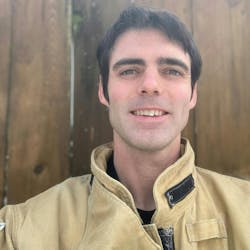Benefits of Firefighter Instruction: Theirs and Yours
Co-instructing at the Kitsap Fire Academy’s (KFA) Class 2024-01 left me a little heartbroken, a little exhausted, and recovering from numerous mild sprains and strains. The 15-week program was a grind, but for the first time in my working life, I was hopping out of bed before the 5:00 a.m. alarm: The recruits, administrative staff and team of instructors made the experience a deeply satisfying personal and professional journey. We laid the groundwork for what 23 recruits could expect of the fire service and what the fire service and its crews, departments and communities expected of them.
Not all of the 23 recruits completed the program. Some discovered that the fire service isn’t their path. Injury prevented others from continuing. Nevertheless, even the struggles and growth of those who didn’t complete the program shouldn’t go unrecognized. We pushed some to the brink of their fears and hit them hard with physical training—all the while exemplifying good leadership.
I didn’t arrive at the KFA feeling like the firefighter who I and the other instructors were inspired to create. I struggle as much as, and at times more than, my peers. However, in this setting, my struggles became teachable moments. They empowered me with empathy and the ability to push physical and mental limits more accurately.
Present and future of the fire service
Up until this point in my career, I spent six years at East Jefferson Fire Rescue in Port Townsend, WA. I dipped my toes in various trainings, department business and union activities. I searched for what I excelled in and had love for. I needed more from work than something that I was proficient at.
My department provided many opportunities to explore the niches: marine operations, ladder truck operations, wildland, paramedic training, technical rescue, and acting officer training. However, I didn’t find what I sought. I was working at a rural station and was lackluster in my personal relationships. Things seemed a little gray.
Being a badass firefighter wasn’t a requirement to teach; however, being competent and having experience certainly was. I started Day 1 motivated by the responsibility to deliver good training and knowing that I needed some work, too. In accepting what I was, without shame, I could focus on becoming a better instructor and a better firefighter. That mentality put me on the path toward feeling a small piece of social psychologist Abraham Maslow’s pinnacle of self-actualization. Self-actualization and Maslow’s hierarchy of needs were concepts that were presented in our instructor cadre orientation. Self-actualization is a state of mind that embraces one’s failures without fault, in a persistent stride toward being everything that you possibly can be. No matter what happens, you take step after step into challenges moving forward without shame or pride in your last step.
I fell in love with the work of instructing and with my team. The experience ignited and invigorated confidence in my abilities as a firefighter and leader. I deepened my appreciation for the education that I received in my academy and passed on experiences that I learned from my peers. Being an instructor was more than instructional lecture and the grind of the drill ground. It was a combination of coaching, team building, counseling and a never-ending leadership exercise. All of this was wrapped into a commitment that the work that instructors put in was about preparing recruits for the more difficult and rewarding journey beyond the academy gates. Every day felt as though we were having an effect on the present and future fire service.
Pursuit of potential
The academy set a high bar in skill execution, but as instructors, we wanted the expectations to be realistic. We did daily physical training with the recruits. We ran 3–5 miles a few times per week, did a half Murph workout, a pacer workout, a circuit and high-intensity interval training (HIIT). We threw the ladders, took the hydrants, deployed the lines and did the academy’s combat challenge.
We encouraged competition. If taking a hydrant with a gate valve needed to be done in 90 seconds, competition drove recruits to get it in 54 seconds. If forcing an inward swinging door needed to be done quickly and correctly, then competition drove recruits to do it in 6 seconds or with a ridiculous tool called a crash axe. We had fun in competition and found a way to share love for the work through it.
Almost 80 percent of the academy class were career members who were attending their first academy. We had a master diver, a flight instructor, members who had career experience in military operations, a teacher, an accountant, a professional cyclist and a marine biologist. In some cases, they were a badass in their field prior to entering the fire service. However, the vocational skills that firefighters possess aren’t common in other industries and certainly not common knowledge. We pushed them hard to reach their potential.
At times, it was uncomfortable to witness them struggle. At the same time, the struggles were inspiring and still fuel my drive to improve today. Thank you KFA Class 2024-01. The pursuit of potential is where exemplary firefighters are born.
Attitude, effort, performance, teamwork
I want to tell you that we graduated the meanest and leanest academy class in history, but we know some will struggle in one area or another. What I can tell you is that we succeeded in building a strong team, a mindset and a foundation.
How did the instructors accomplish this? One notable aspect was that the instructors themselves—before the recruits arrived—were put into a situation in which teamwork and leadership were required and in which none of the instructors had experience: rowing a racing scull. That was followed by a talk that was led by a business leadership expert, to help give substance to the experience.
As for direct influence on the recruits that built a strong team, mindset and foundation? There were numerous elements. Among these:
- Recruits were reminded frequently that one firefighter can’t do all of the jobs on the fireground him/herself. “You need a team, because the best nozzle firefighter can’t be effective without an engineer or hydrant firefighter to send water.”
- Recruits were prompted repeatedly that they are human, not super human. “We make mistakes, we get fatigued, and we have a lot of technical areas to be proficient in. We have to lean into our discomfort and tap into the experience that others offer. Accept that you have weak spots and work on them. Accept and love yourself in spite of that truth, and you’ll be able to support others through their challenges.”
- Recruits were expected to give positive reinforcement to each other. Nonconstructive messaging between recruits wasn’t permitted.
Individual teams of recruits started to galvanize around the fourth week, when the recruits knew that, although not everyone was performing at the same level, all recruits were putting in 100 percent of their effort to improve.
Badass isn’t a title that people give themselves, and I can’t give it to my own academy recruits. KFA’s guiding values will be a part of their career moving forward: attitude, effort, performance, teamwork. Striving toward those values and how they show up in an individual help to give the recruits a confident attitude that they will win on the fireground. The instructors fed this through repeated, multiple sets and repetitions; as many as nine days of live fire training; and simulated fire responses. Nothing provides confidence better than performing a skill in a realistic scenario.
Recruits must continue to develop maximum grit in their efforts even when confidence is in question. They must seek to improve performance by acquiring skills to back up their attitude and efforts. During one lecture that I gave, I said something like, “The fire service is in a time where our most experienced members are leaving. We face fewer fires, which hinders departments’ capability to make up for the lack of experience. The increased needs of the community of the services that we deliver allow less time to develop expertise in one area. At some point in your future—and maybe sooner than you’re ready for—you will have to take on a leadership role. Before long, you will be the senior firefighter guiding a probationary firefighter.”
Veterans’ role
Teamwork acts as a propellant toward success. In Maslow’s hierarchy of needs, security in one’s social group precedes self-actualization and the inner drive to seek peak ability. Seasoned firefighters have confidence in their skills and execute them, but our newest team members might not easily do the same. It’s the duty of their new teammates to be present and supportive, because they will experience a variety of failures, and it shouldn’t be surprising when it occurs.
Understandably, there is a proving time for the new generation of firefighters as they enter their respective firehouse and probationary period. Good teammates refuse to settle for failure but still accept the undesirable outcome that occurred. In doing so, you can learn and move forward without getting caught up in the present outcome. You should look to push potential further, not accept its current limit.
Badass firefighters understand that they are a part of something greater and seek understanding of the bigger picture. They build connections rather than keep people at arm’s length. They rely on peers as needed and offer support when their strengths can make the difference. Your many strengths will make a difference with recruits.
Better suited than you might realize
I loved my experience as an instructor and encouraging others to consider this path. If you enjoy showing the newest firefighters or volunteers what you know, then you might already be a better fit than you realize. The KFA program made it easy to be a successful instructor. I have no doubt that you can find a similar experience to mine.
Thanks to the guys who pushed through this every day alongside me, offering their depth of wisdom, support and experience: lead instructor Bobby Jones of South Kitsap Fire and Rescue (SKFR) (Port Orchard, WA) and co-instructors Erik Stanley (SKFR) and Josh Pippinger (Bainbridge Island, WA, Fire Department). Additional thanks to the many other instructors who volunteered to teach their specialties in vertical ventilation, search, nozzle-forward techniques, hazmat, EMS, vehicle extrication, health and wellness, and fire investigation.
About the Author

Patrick Williams
Patrick Williams is a firefighter/EMT-B who currently serves with East Jefferson Fire Rescue in Port Townsend, WA. His service as a career firefighter has spanned seven years.
